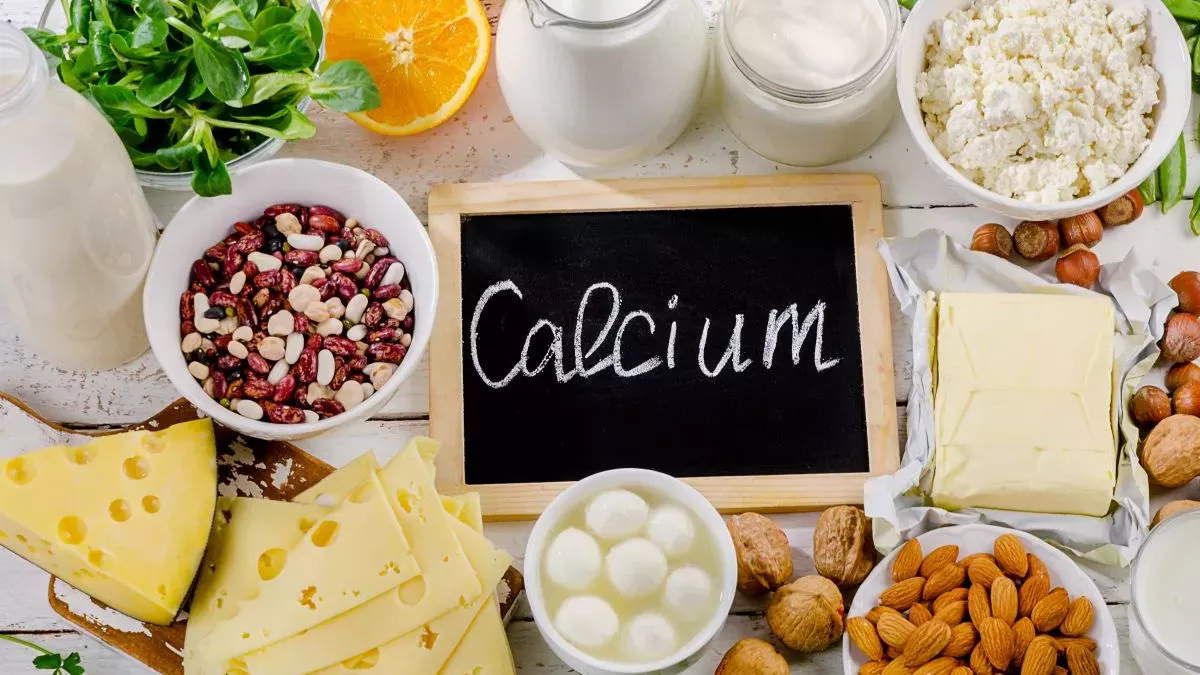Verified on 12/19/2023 by PasseportSanté
Calcium is the most abundant mineral in the human body, every day we must ensure a good calcium intake through diet. Known for its role in bone mineralization, calcium is just as important for the nervous system and blood clotting. The requirements of a healthy adult are 900 to 1000 mg per day.
Characteristics of calcium:
- essential mineral for the mineralization of bone and teeth;
- vitamin D allows it to attach to bones;
- is found in dairy products, tofu and some drinking water;
- calcium deficiency is a risk factor for osteoporosis and fractures;
- needs are increased among adolescents, the elderly and pregnant women.
Why consume foods rich in calcium?
Mineralization of bone
Calcium is involved in the mineralization of bone tissue and teeth. It ensures the strength and rigidity of bones and dental enamel. More than 99% of the calcium is thus lodged in the bone.
At any stage of life, calcium has an important role:
- in children it allows bone growth;
- in adults, the maintenance of bone stock;
- among seniors, he warns ofosteoporosis and fractures.
Muscle contraction
Calcium intervenes at the level of neuromuscular excitability and allows the muscle to contract. It is also necessary for muscle relaxation after contraction and for the proper functioning of the heart muscle.
Coagulation sanguine
This mineral allows blood to clot and tissues to heal properly.
Brain functioning
Essential for neuromuscular excitability, calcium intervenes in the conduction of nerve impulses. It also plays an antidepressant role and promotes sleep.
What foods are rich in calcium?
It is important to include enough foods containing calcium in the diet to cover the body’s needs and to avoid a deficiency. Calcium is mainly found in cheese, tofu products and dairy products.
|
Food |
Portions |
(mg) |
|
Firm tofu made with calcium sulfate |
100 g |
683 mg |
|
Cheeses: Gruyere and Parmesan |
50 g |
506-592 mg |
|
Cheeses: Emmental, Cheddar, Edam, Gouda, Provolone, Roquefort, Swiss |
50 g |
331-396 mg |
|
Fortified soy drink |
250ml (1 cup) |
320-370 mg |
|
Canned sardines with bones |
100 g (8 medium) |
382 mg |
|
Ricotta cheese, partially skimmed milk |
125ml (1/2 cup) |
356 mg |
|
Regular tofu prepared with calcium salt |
100 g |
350 mg |
|
Goat’s milk |
250ml (1 cup) |
345 mg |
|
Cow’s milk, 0%-3.25% fat |
250ml (1 cup) |
291-333 mg |
|
Yaourt nature, 0 %-3.25 % MG |
175 ml |
253-332 mg |
|
Fortified rice drink |
250ml (1 cup) |
319 mg |
|
Cheeses: camembert, blue, feta, mozzarella |
50 g |
194-288 mg |
|
Canned salmon with bones |
100 g |
239-277 mg |
|
Cooked black peas |
250ml (1 cup) |
223 mg |
|
Cooked white beans |
250ml (1 cup) |
170 g |
|
Orange juice, enriched with calcium |
125ml (1/2 cup) |
155 mg |
|
Boiled cabbage |
125ml (1/2 cup) |
141 g |
|
Atlantic perch, grilled |
100 g |
137 mg |
|
Tofu prepared with magnesium salt |
100 g |
135 mg |
|
Boiled spinach |
125ml (1/2 cup) |
129 mg |
 Receive every day
Receive every day
advice from our experts
to take care of you

Waters rich in calcium
Beyond food, certain waters particularly rich in calcium can help meet the body’s needs. Water is said to be rich in calcium if it contains more than 120 mg of calcium per liter.
Among the waters rich in calcium we find:
- Hepar;
- Courmayeur;
- Contrex;
- Salvetat;
- Quézac.
Daily Calcium Needs
|
Nutritional reference for the population (RNP) |
|
|
Babies 0-6 months |
200 mg |
|
Babies 7-12 months |
280 mg |
|
Babies 1-3 years old |
450 mg |
|
Children 4-6 years old |
800 mg |
|
Children 7-10 years old |
800 mg |
|
Children 10-12 years old |
1 150 mg |
|
Adolescents 13-15 ans |
1 150 mg |
|
Adolescents 16-19 ans |
1 150 mg |
|
Men 19-60 years old |
950 mg |
|
Women 19-60 years old |
950 mg |
|
Men aged 60 and over |
950 mg |
|
Women aged 60 and over |
950 mg |
|
Pregnant women |
950 mg |
|
Breastfeeding women |
1 000 mg |
Calcium-based food supplements
In food supplements, calcium is often combined with other nutrients such as vitamin D or even phosphorus. These supplements are often indicated for the maintenance of bone stock and during growth.
Noticed
The dosage varies according to age, problem and context. Ask your doctor for advice.
Lack of calcium: what are the consequences?
In the event of a deficit in calcium intake, the serum calcium (calcium level in the blood) is self-regulated by drawing the necessary calcium directly from the bone tissue. In the long term, the symptoms of a lack of calcium are therefore bone-related:
- rickets;
- osteoporosis;
- increased risk of fracture;
- etc.
A deficiency in this mineral can also cause thyroid disorders (hyperparathyroidism) if it is associated with a lack of vitamin D intake.
High calcium levels in the blood: what are the effects?
Hypercalcemia, or too high a level of calcium in the blood, can induce hypercalciuria (increase in the level of calcium in the urine) and the formation of kidney stones and calcium deposits in the urinary tract and kidneys. Calcium intake should never exceed 2 g per day.
Calcium and interactions with other nutrients
Certain factors disrupt the proper assimilation of calcium or increase its elimination through the urine, such as:
- phytates present in the shell of whole grains;
- you sell;
- proteins.
Excess calcium can also disrupt the assimilation of other nutrients such as:
- magnesium;
- le zinc ;
- the iron.
Finally, a good intake of vitamin D is essential to allow the fixation of calcium in bone tissue.
Chemical properties
The symbol for calcium is Ca, its atomic number is 20. It is an earthy metal with a light gray to white color. The atomic molar mass of calcium is 40.078 u. It is the fifth most abundant mineral in the earth’s crust and the first in the human body.
Calcium carbonate is composed of carbonate and calcium ions. It is the constituent of chalk, marble and the shells of certain animals.
Calcium chloride is a calcium salt particularly recognized for its exothermic properties. It is what we use in cement, to clear snow from roads or even to make refrigerators.
Calcium hydroxide consists of calcium and hydroxyl and is the major constituent of lime water and milk of lime.
Finally, calcium sulfate comes in the form of a white powder swelling in water. In food, this is the additive E516 used for its firming and stabilizing properties.
History of calcium
Calcium has been used in lime preparations by the Romans since the 1st century. It was not until 1800 that calcium was discovered and identified as a mineral in its own right. It was H. Davy who was the first to isolate it. From that point on, calcium has been the subject of thousands of studies and has become a focus of interest for many scientific fields.
Our dietitian’s opinion
Calcium is by far the most abundant mineral in the body! Covering calcium needs is therefore a necessity at all ages of life to ensure growth and then to prevent the risks of fractures and osteoporosis later. A varied and balanced diet in principle allows us to satisfy our calcium needs throughout life since it is present in good quantities in many foods of animal… and plant origin!
95% Readers found this article helpful And you ?
Was this article useful to you?












